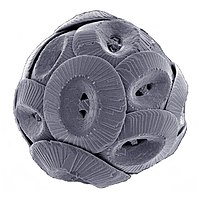
Photo from wikipedia
Abstract This paper reports a facile strategy to covalently immobilize nanosized carbon dots (CD) onto carbon conductive surfaces for sensing applications. The carbon nanodots designed with surface amine groups (N-CD)… Click to show full abstract
Abstract This paper reports a facile strategy to covalently immobilize nanosized carbon dots (CD) onto carbon conductive surfaces for sensing applications. The carbon nanodots designed with surface amine groups (N-CD) can be electrografted onto carbon electrodes and, thus, easily covalently immobilized on these conductive surfaces. They have been synthetized by a carbonization method microwave-assisted using preselected low cost and biocompatible precursors, such as d -fructose as primary carbon source and urea as N-donor reagent to obtain peripheral enriched nitrogen CD. The synthetized nanomaterial has been characterized by different techniques, that confirm the presence of size-regular amorphous structures with blue fluorescence when are irradiated with UV light. The highly stable immobilization of N-CD onto the electrode surfaces by electrografting provides hybrid electrodes with greater relative surface area and improved electron transfer properties, demonstrating to be a great promise for electrochemical sensing. Because of its good electrical conductivity, electrical properties, abundant edges sites and high catalytic activity, N-CD immobilized on carbon electrodes efficient amplify the electrochemiluminiscence (ECL) signal from the luminophore [Ru(bpy)3]2+ in a taurine sensor. A linear concentration range from 126 to 1000 μM, a sensitivity of 7.40ⅹ10−4 μM−1 and a detection limit of 37.8 μM were determined for the taurine sensor.
Journal Title: Carbon
Year Published: 2020
Link to full text (if available)
Share on Social Media: Sign Up to like & get
recommendations!